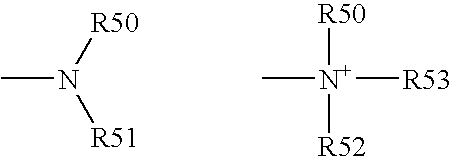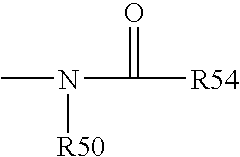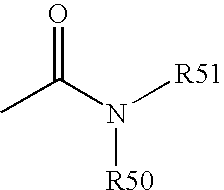[0193] Functional compounds having
metal binding properties can be easily introduced to the
micelle by: (1) creating a third
copolymer component that bears the functional group and (2)
coupling the
copolymer to the surface of a pre-assembled polymeric
micelle. Alternatively, a
metal binding domain-bearing component can be incorporated into a
micelle at the time the micelle originally forms. If so, then it may be preferable to use a
copolymer wherein the
metal binding domain resides in the hydrophilic segment so that it is exposed in the micelle
surface layer. It is an
advantage of the present invention that the kind and content of the functional group can be easily changed without limitation.
[0194] Micelles according to the present invention may comprise biodegradable, biocompatible copolymers, resulting in non-
immunogenicity and non-
toxicity. In one aspect copolymers disclosed herein degrade into non-toxic, small molecules subject to renal
excretion and are
inert during the required period of treatment. Degradation may occur via simple hydrolytic and / or enzymatic reaction. Degradation through simple
hydrolysis may be predominant when the backbone of a copolymer comprises ester bonds.
Enzymatic degradation may become significant in the presence of certain organelles such as lyposomes. The degradation period can be varied from days to months by using polymers of different kinds and molecular weights. In one example, the present invention may use biodegradable polyesters or polypeptides possessing safe and biocompatible degradation pathways. In addition, the highly-branched micellar structure of the present invention may further reduce
cytotoxicity since branched polycations such as dendritic polyamidoamines are thought to be less cytotoxic than linear polycations. Accordingly, the advantageous components and structure of
polymeric micelles according to the present invention can be appreciated regarding reduced
cytotoxicity. For additional examples of micelles, reverse micelles, liposomes, and microspheres suitable for the present invention see U.S. Pat. Nos. 6,338,859, 5,631,018; 6,162,462; 6,475,779; 6,521,211; and 6,443,898.
[0196] Emulsions as the carrier in the present invention relate to emulsions of an aqueous or an aqueous-organic continuous phase and an organic discontinuous phase, the latter containing an
organic solvent which is not miscible with water. Hydrogels are similar and refer to a type of gel in which the disperse phase has combined with water to produce a semisolid material. The emulsions and hydrogels used in the present invention may contain organic compounds from the group of the reaction products of alkylene oxides with compounds capable of being alkylated, such as, for example, fatty alcohols, fatty amines, fatty acids,
phenols, alkylphenols, carboximides and resinic acids, preferably balsamic resin and / or
abietic acid.
[0197] Organic solvents which are not miscible with water include, for example, aliphatic, cycloaliphatic or aromatic hydrocarbons or the acetate-type solvents. Suitable as organic solvents are, preferably, natural, fully- or semisynthetic compounds and, if appropriate, mixtures of these solvents which are fully miscible or soluble with the other compounds of the
emulsion in the temperature range of from 20 to 130.degree. C. In one embodiment, suitable solvents are those from the group of the aliphatic, cycloaliphatic or aromatic hydrocarbons which are liquid at
room temperature, including oils, such as, for example, mineral oils, paraffins, isoparaffins, fully-synthetic oils such as
silicon oils, semisynthetic oils based on, for example, glycerides of unsaturated fatty acids of medium
chain length, essential oils, esters of natural or synthetic, saturated or unsaturated fatty acids, for example C.sub.8-C.sub.22 -fatty acids, C.sub.8-C.sub.18 -fatty acids, especially preferably methyl esters of
rapeseed oil or 2-ethylhexyl laurate, alkylated aromatics and their mixtures, alkylated alcohols, in particular fatty alcohols, linear, primary alcohols obtained by
hydroformylation,
terpene hydrocarbons and naphtene-type oils, such as, for example, Enerthene. Further organic solvents include those from the group of the acetate-type solvents such as, for example, 1,2-
propanediol diacetate, 3-methyl-3-methoxybutyl acetate,
ethyl acetate and the like. The solvents can be employed individually or as mixtures with each other.
[0198] The continuous aqueous or aqueous-organic phase of the active-agent-containing emulsions or microemulsions according to the present invention contain water, an
organic solvent that is soluble or miscible in water, and may also contain at least one natural or synthetic surface-
active agent which has a
solubility of >10 g / l, in particular >100 g / l in water (d) at 20.degree. C., and, if appropriate, further adjuvants. Organic solvents which are soluble or miscible in water have a
solubility in water of >5.0 g / l at 20.degree. C., in particular >15 g / l.
[0199] Examples of suitable organic solvents are: aliphatic C.sub.1-C.sub.4 -alcohols such as
methanol,
ethanol, isopropanol, n-
propanol, n-
butanol,
isobutanol or tert-
butanol, aliphatic ketones such as
acetone, methyl ethyl
ketone,
methyl isobutyl ketone or
diacetone alcohol, polyols, such as
ethylene glycol,
propylene glycol, butylene glycol, 1,4-
butanediol, 1,5-pentanediol, 1,6-hexanediol,
diethylene glycol,
triethylene glycol,
trimethylolpropane,
polyethylene glycol or
polypropylene glycol with a mean
gram-molecular weight of 100 to 4000 g / mol or 200 to 1500 g / mol, or
glycerol, monohydroxyethers, such as monohydroxyalkyl ethers or mono-C.sub.1-C.sub.4 -
alkyl glycol ethers such as
ethylene glycol monoethyl
ether,
ethylene glycol
monomethyl ether,
diethylene glycol monomethyl ether or diethylene glycolmonoethyl
ether,
diethylene glycol monobutyl
ether,
dipropylene glycol monoethyl ether,
thiodiglycol,
triethylene glycol monomethyl ether or
triethylene glycol monoethyl ether, furthermore 2-pyrrolidone, N-methyl-2-pyrrolidone, N-ethyl-pyrrolidone, N-vinylpyrrolidone, 1,3-dimethylimidazolidone,
dimethylacetamide and
dimethyl formamide.
 Login to View More
Login to View More 


